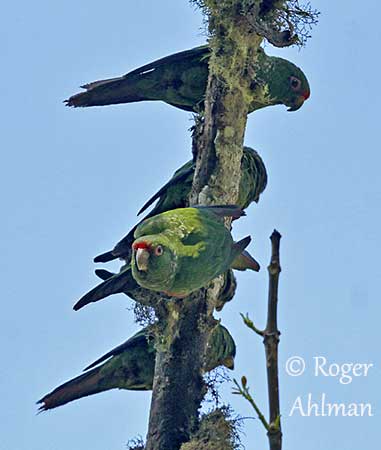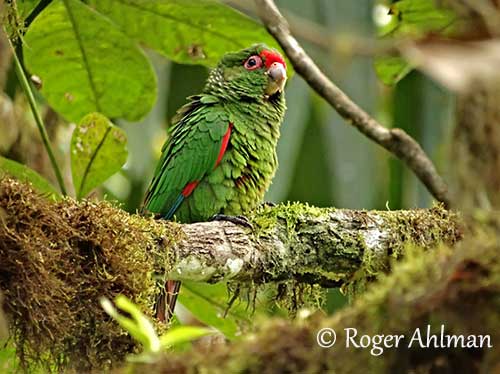
Fr : Conure d’Orcès
Ang : El Oro Parakeet
All : Orcessittich
Esp : Cotorra de El Oro
Ita : Parrocchetto di El Oro
Nd : El-Oroparkiet
Sd : eloroparakit
Photographer:
Roger Ahlman
Pbase Galleries Peru and Ecuador & My bird pictures on IBC
Text by Nicole Bouglouan
Sources :
HANDBOOK OF THE BIRDS OF THE WORLD vol 4 by Josep del Hoyo-Andrew Elliott-Jordi Sargatal - Lynx Edicions - ISBN: 8487334229
PARROTS OF THE WORLD – An Identification Guide – by Joseph M. Forshaw – Princeton University Press – ISBN 0691092516
Rainforest Trust - Saving the El Oro Parakeet
World Land Trust – Buenaventura Reserve
Neotropical Birds – Cornell Lab of Ornithology
Wikipedia, la enciclopedia libre
El Oro Parakeet
Pyrrhura orcesi
Psittaciformes Order – Psittacidae Family
INTRODUCTION:
The El Oro Parakeet is included in the tribe Arini that gathers the Neotropical parrots within the large family Psittacidae. They are set apart from Old World parrots by behavioural and morphological features.
This species is endemic to Ecuador. It was discovered in 1980, and described only in 1988.
It lives in humid tropical forest. It is threatened by deforestation and fragmentation for cattle ranching. The habitat is now restricted to the W Andes of Ecuador and some protected reserves where nest-boxes allow this parakeet to breed with some success.
The El Oro Parakeet is currently listed as Endangered.

DESCRIPTION OF THE BIRD:
Biometrics:
Length: 22 cm
Weight: 65-75 g
The El Oro Parakeet adult has green plumage overall, with blue and red areas.
The male has red lores and forehead. On the wings, bend of wing, carpal edge and primary coverts are red. The flight-feathers are blue. The graduated tail is green at base, with dark brownish-chestnut central rectrices and tip.
On the underparts, the belly is washed dull reddish. The undertail appears redder. The flight feathers are whitish.
The bill is horn-coloured. The eyes are dark brown, surrounded by bare, pale pinkish-white eyering. Legs and feet are blackish-grey.
The female resembles male but she has green lores and more reduced red area on the forehead.
The juvenile is duller than female, with less red on forehead and bend of wing, and uniformly green belly.
RANGE:
The El Oro Parakeet is endemic to Ecuador where it can be found on Pacific slopes of the Andes in SW Ecuador, from Manta Real to Buenaventura Reserve (El Oro).
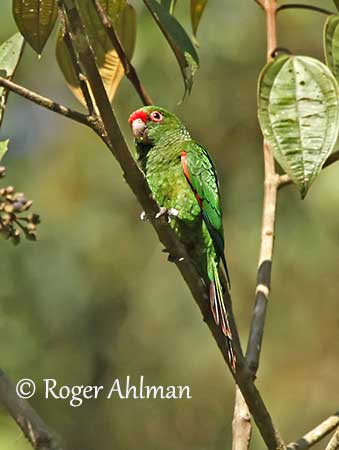
HABITAT:
The El Oro Parakeet is usually scarce, but locally fairly common in patches of tropical cloud forest, between 800 and 1,200 metres of elevation. It also frequents adjacent cultivated areas and orchards around 300 metres of elevation.
CALLS AND SONGS: SOUNDS BY XENO-CANTO
The El Oro Parakeet is very noisy and conspicuous in flight. It gives a harsh, trilling “tchreeet…tchreeet”. When perched, it utters quieter chirruping notes “krrrr”. Groups in flight produce a noisy chattering.
BEHAVIOUR IN THE WILD:
The El Oro Parakeet feeds on various fruits (Ficus species) and fruits and flowers of Cecropia. It also takes berries.
It feeds discreetly in upper stages and canopy of the forest, and often returns to the same fruiting tree.
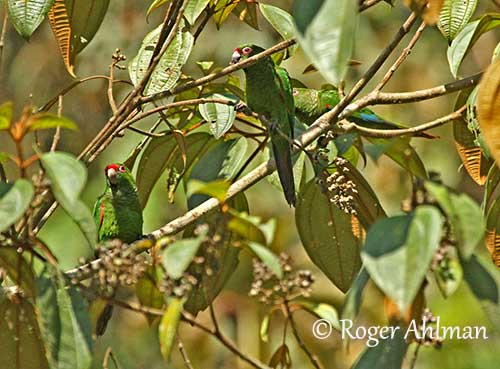
The El Oro Parakeet is often seen in small groups of 4-15 birds, occasionally in flocks of 40-60 individuals outside breeding season.
They roost in cavities in trees and branches, several metres above the ground. But the sites change frequently.
During the breeding season, it can be seen in pairs or family groups. But very little is known about its behaviour.
The pair gives territorial vocalizations early in the breeding period, often loud calling given from high perch.
The breeding seems to be communal, with several birds sharing the nesting duties.
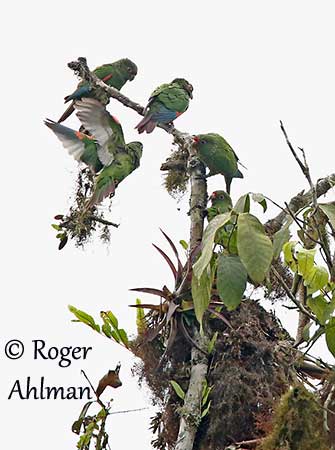
The El Oro Parakeet is resident within its reduced range. It may perform seasonal and altitudinal movements to reach suitable forested habitats at lower elevation.
The flight is fast through or above the forest canopy.
REPRODUCTION OF THIS SPECIES:
The breeding season takes place mainly between November and March. However, during El Niño effect, they can breed in December/January.
Due to heavy deforestation, the El Oro Parakeet nests in nest-boxes in Buenaventura Reserve. In 2006, 39 artificial nest boxes were closely monitored. However, this species also nests in natural cavities in various tree species, between 2 and 24 metres above the ground.
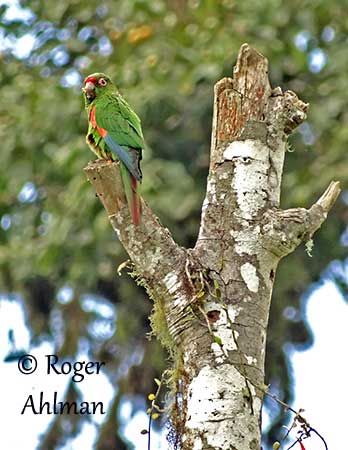
The female lays 3-4 white eggs. The incubation lasts about one month. From an observation, fledged young were fed by adults in June and August, involving that breeding may extend from March to July.
All members of the group (3 to 9 birds) share the nesting duties. Several individuals incubate, including young from the previous season. Each member incubates during 3-4 hours. The chicks are probably fed by regurgitation, 3-4 times per day.
Some predators, and especially the Crimson-rumped Toucanet, may steal the eggs or disturb the birds.
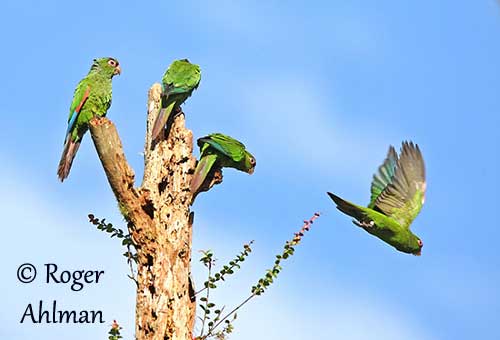
PROTECTION / THREATS / STATUS:
The El Oro Parakeet has very restricted range in Ecuador. The species is threatened by degradation of the habitat, through deforestation and fragmentation for cattle ranching.
This species is mainly found in Buenaventura Reserve, established in 1999 by Jocotoco Foundation. This is today an area of 2353 hectares (5816 acres). Nest-boxes were built to help the birds and these artificial nests were rapidly accepted. The resulting breeding success boosted the population size.
The population is estimated to number less than 1,000 individuals, with only 300-400 birds in 2014. It is still declining.
The El Oro Parakeet is currently listed as Endangered species.
